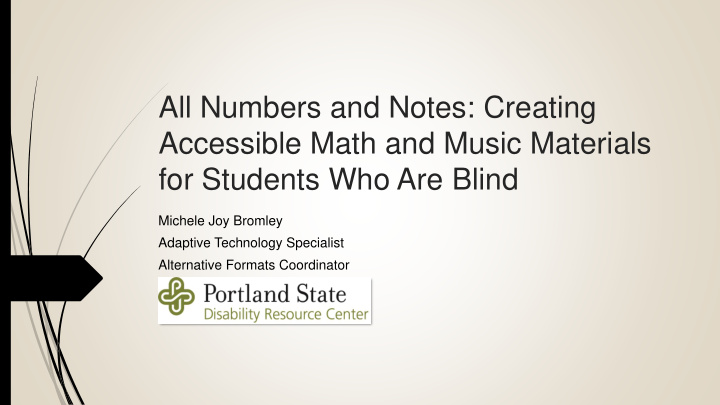



All Numbers and Notes: Creating Accessible Math and Music Materials for Students Who Are Blind Michele Joy Bromley Adaptive Technology Specialist Alternative Formats Coordinator
Approaching Alternative Formats for Blind Students: Where to Begin Generating a Basic Alternative Formats Production Workflow Administering an Alternative Formats Needs Assessment Breaking Down Alternative Formats Conversion for Simpler PDF and PowerPoint Files for More Complex PDF and Image Files for Math and Music Understanding Equipment Requirements for In-house Conversions Keeping Vendors on Speed Dial for Contract Conversions Communicating with Faculty before the Start of the Term
Generating a Basic Alternative Formats Production Workflow Think about the students for whom you are providing alternative formats. Will they be taking any science, technology, engineering, art, and mathematics (STEAM)? What tools are they using to access their alternative formats? Regardless of your standard workflow, converted materials to a fully accessible format (for screen reader users) is a different ball game. Electronic files from the publisher are not enough. Scans run through optical character recognition are not enough.
Generating a Basic Alternative Formats Production Workflow, Continued When creating accessible, alternative formats for blind students, disabilities services professionals must consider: descriptions of images, graphs, diagrams, etc. linear reading order nested numbered and bulleted lists accessible data tables clear heading structure navigable, descriptive links references to any supplemental materials (tactiles, music files, etc.)
Administering an Alternative Formats Needs Assessment Determine the tools to which students have access: Do they have a laptop equipped with screen reading software? What operating system do they use? Which screen reading software do they use? Do they have access to a refreshable braille display? Determine the skills students have versus the skills they will need to acquire: Do they read braille? Music braille? Nemeth? Do they have experience with tactile graphics?
Breaking Down Alternative Formats for Simpler PDF and PowerPoint Files Portable Documents Files PowerPoint Files Run the file through optical character Remove any animations. recognition. Fix reading order. Ensure page numbers match the Add alternative text to any images. page numbers from the original PDF. Add heading structure as necessary. Add alternative text to any images. Designate the header row for each data table.
Breaking Down Alternative Formats for More Complex PDF and Image Files Run the original file through optical character recognition software. Save as a Microsoft Word document. Edit the Microsoft Word document to include: descriptions of images, graphs, diagrams, etc. linear reading order nested numbered and bulleted lists accessible data tables clear heading structure navigable, descriptive links references to any supplemental materials (tactiles, music files, etc.)
Breaking Down Alternative Formats Conversion for Math and Music So, what about math? If the student does not read LaTeX, then in addition to the remediation described previously for complex PDF and image files: Equations must be input via an accessible equation editor. When the Microsoft Word document is complete, it may need to be saved in an additional format wherein equations will be accessible to the student. Does the student have access to MathType, MathPlayer, etc.? Does the student read Nemeth braille?
Breaking Down Alternative Formats Conversion for Math and Music, Continued And what about music? In addition to the remediation described previously for complex PDF and image files: In-text bars of music or full sheet music must, at minimum, be translated into music XML (MUSX). When the initial music XML file is complete, it may need to be exported to into music braille (BRF). Does the student read music braille? Does the student have experience with music notation software?
Understanding Equipment Requirements for In-house Conversions Book Cutter (like the MBM Triumph 4705) Duplex Scanner (like the Canon imageFORMULA DR-G1100) Optical Character Recognition Software (like ABBYY FineReader, InftyReader, OmniPage, and SharpEye) PDF Editing Software (Adobe Acrobat Pro) Note: Adobe Reader will not allow you to manipulate and/or edit files. Presentation Software (PowerPoint) Word Processing Software (Microsoft Word) Braille Translation Software (like Duxbury Braille Translator) Braille Embosser (like the VP Max or the Basic-D V5) Tactile Graphic Embosser (like the PIAF)
Understanding Equipment Requirements for In-house Conversions, Continued We’re not done! For STEAM materials, you would need: Accessible Equation Editor (MathType) MP3 Converter w/Math Capability (like Central Access Reader) Music Notation Editor (like Finale or Sibelius) Music Braille Translator (GOODFEEL)
Keeping Vendors on Speed Dial for Contract Conversions Accessible Text Conversion (like AMAC or the Ogden Resource Center) Accessible Tactile Conversion (like the Ogden Resource Center) Accessible Music Conversion (like AMAC, Bach to Braille, Dancing Dots, or the Ogden Resource Center) Accessible Video Conversion (like 3PlayMedia)
Communicating with Faculty before the Start of the Term Communicating Early Introductory email from the Director Follow-up emails from the responsible DS provider Midterm email from the responsible DS provider End-of-term email from the responsible DS provider Explaining Clearly Outlining DS responsibilities versus faculty responsibilities Explaining how and when materials and information must be shared Reminding Often
Communicating with Faculty before the Start of the Term, Continued Plan to queue the conversion of textbook chapters according to a course reading schedule. Convert and provide access to materials as they are needed. For example, if a chapter is assigned in the second week of the term, ensure that the student receives an accessible copy in the first week of the term (at minimum). Create a system by which instructors can share supplemental course materials (PowerPoints, handouts, assignments, articles, etc.) at least three business days before their planned distribution, posting, or show date. Allow instructors to create materials throughout the term; but also, Allow yourself time to convert these materials or send them out for conversion.
Looking for Accessible Design and Remediation Resources? Accessible PDF Design Adobe: PDF Accessibility Overview WebAIM: PDF Accessibility Accessible DOCX Design Microsoft: Creating Accessible Word Documents WebAIM: Microsoft Word Accessible PPT Design Microsoft: Creating Accessible PowerPoint Presentations WebAIM: PowerPoint Accessibility Alternative Formats Guidelines for Creating Accessible Digital Materials for Blind Students
Questions? michele.bromley@pdx.edu 503-725-8395
Recommend
More recommend